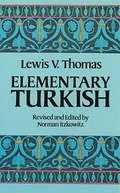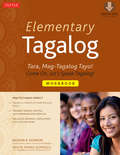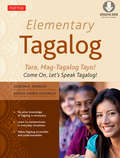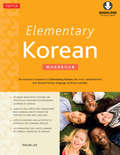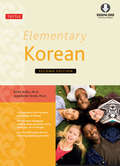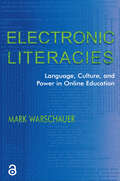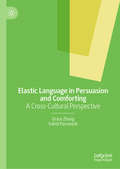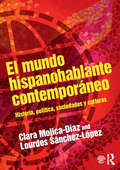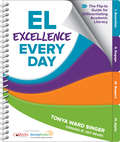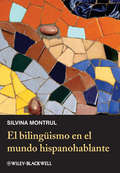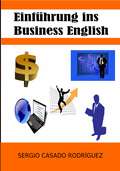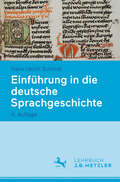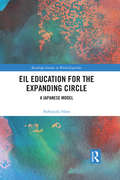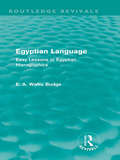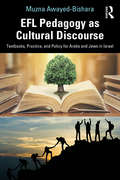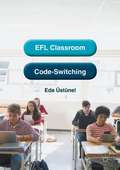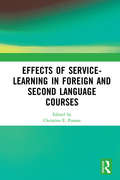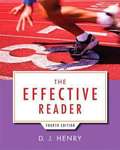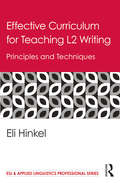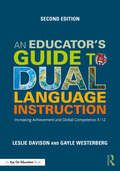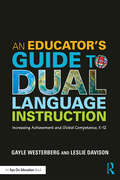- Table View
- List View
Elementary Turkish (Dover Language Guides)
by Lewis ThomasTurkish is the primary language of some thirty million people. Anyone concerned with current social, political, and cultural developments in Turkey knows that a practical understanding of the basic patterns of modern Turkish is an invaluable skill that until now has been difficult to attain without extensive training.This superb grammar and exercise text, used successfully for years in Princeton University, enables English-speaking students — in and out of the classroom — to gain a quick and thorough understanding of modern Turkish. In a carefully arranged sequence of 23 lessons, Lewis V. Thomas, late Professor of Oriental Studies at Princeton, presents thorough coverage that allows the student to begin to use the basic patterns of modern Turkish without time-consuming and expensive private instruction.The method of instruction was devised after an extensive analysis of results in Princeton classrooms, and relies on exercises at the end of each lesson to test the student's grasp of the material. Beginning with the alphabet and numbers, Professor Thomas offers clear, concise coverage of articles, adjectives and nouns, common infinitives, personal pronouns, and elementary verbs. As the student's comprehension of basic elements develops, further lessons deal with more complicated subjects such as the possessive construction, past general verbs, postpositions, the partitive, progressive verb forms, and abbreviating verb forms. A complete Turkish-English glossary translates new vocabulary occurring in the exercises.Norman Itzkowitz, Professor of Near Eastern Studies at Princeton University, has skillfully made the necessary revisions and additions to complete Professor Thomas' work. For anyone who needs to communicate in this important and influential language, Professor Thomas' proven course, now in an inexpensive paperback edition, is the most effective method available.
Elementary Tagalog Workbook: Tara, Mag-Tagalog Tayo! Come On, Let's Speak Tagalog!
by Jiedson R. Domigpe Nenita Pambid DomingoTara, Mag-Tagalog Tayo!Come On, Let's Speak Tagalog!Elementary Tagalog's comprehensive approach will help students master the basics without frustration. <P><P>From learning to read Tagalog words and pronounce its sounds to using correct grammar, communicating in dialogues and building vocabulary, learners will be surprised at how quickly their skills in Tagalog develop. The expert guidance in Elementary Tagalog is carefully sequenced to be the most effective and supportive for beginners.Covering a range of topics, the lessons center on themes from the family, the home, and the community to food, travel, health, leisure time, festivals and popular culture. There are plenty of exercises, activities and practice drills to help learners acquire and master the language fundamentals, while culture notes explore the diversity, heritage and history of the Philippines.The Elementary Tagalog Workbook is a helpful companion to the textbook and will assist you in practicing and polishing your skills. Each lesson supplements the corresponding lesson in the textbook. There are ten activities per lesson, which offer a range of exercises and practice opportunities to enable you to achieve proficiency in everyday, conversational Tagalog.
Elementary Tagalog
by Jiedson R. Domigpe Nenita Pambid DomingoThis is the leading beginner Tagalog textbook and language learning package.Elementary Tagalog's comprehensive approach will help students master Tagalog, the language of the Philippines, also known as Filipino or Pilipino. From learning to read Tagalog words and pronounce Tagalog sounds to using correct Tagalog grammar, communicating in Tagalog dialogues and building Tagalog vocabulary, learners will be surprised at how quickly their skills develop. The expert guidance in Elementary Tagalog is ideal both for true beginners and heritage learners who grew up in Filipino-speaking communities or families. The accompanying MP3 audio CD improves listening comprehension and ensures correct pronunciation.Covering a range of topics, the lessons center on themes from the family, the home, and the community to food, travel, health, leisure time, festivals and popular culture. There are plenty of exercises, activities and practice drills to help learners acquire and master the language fundamentals, while culture notes explore the diversity, heritage and history of the Philippines. This is a complete language system and no prior knowledge of Tagalog is needed to begin.Elementary Tagalog is composed of twenty-four lessons in eight units. Each Lesson contains: Cultural Notes at the beginning of each unit offering explanations of social, economic and historical aspects of Filipino society. A Vocabulary List in each lesson ties in to the theme of the unit and both the Tagalog reading text and the aural activities presented in the specific lesson. Reading and Reading Comprehension which are presented mostly in the form of Tagalog language dialogues, are designed to expose the students to real-life conversations as might be had by native Filipino speakers. Three Active Learning Activities follow the dialogue and dialogue comprehension in each lesson and ask students to employ the lesson's new Tagalog vocabulary. The Grammar Section is divided into four parts: definitions of terms, examining form, grammar presentation and grammar notes. Practice exercises or activities target student's speaking Tagalog, reading Tagalog, writing Tagalog and Tagalog listening skills. An accompanying audio CD with listening activities to reinforce Tagalog learning is also included with the book.Available separately is the companion Elementary Tagalog Workbook. This helpful workbook will assist you in practicing and polishing your Filipino language skills. Each lesson supplements the corresponding lesson in the textbook. There are ten activities per lesson, offering a range of exercises and practice opportunities to enable you to achieve proficiency in everyday, conversational Tagalog.
Elementary Modern Standard Arabic
by Peter F. AbboudThe Elementary Modern Standard Arabic Course (EMSA) is the premier introduction, for the English-speaking student, to the active written language of the contemporary Arab world. Expressly designed for the beginning student, the course is written by a team of Arabic language teachers consisting of native and non-native Arabic speakers, linguists and people whose primary interests are literature and allied areas. It implements an audio-lingual approach to language teaching while presenting the elements of Modern Standard Arabic as written and spoken in the contemporary Arab World. Volume 1 is complete in itself and presents a practical introduction to the writing system of Arabic and to its pronunciation, with reading and writing pronunciation drills. Thirty lessons provide a basic working knowledge of Arabic. Each lesson contains a text, a vocabulary, grammar and drills including oral and written comprehension passages. An Arabic-English glossary completes the volume. The co
Elementary Korean Workbook
by Insun LeeThis is a extensive beginning level Korean workbook.This helpful practice book is intended as a companion to Elementary Korean but can be used with any other Korean textbook or as a stand alone self-study guide to learn Korean. Elementary Korean Workbook is essential for practicing and polishing your proficiency in everyday conversational beginner Korean. Here are carefully crafted activities for expanding your abilities to read Korean, write Korean, comprehend Korean, and speak Korean. The MP3 audio CD helps build listening comprehension and ensure correct pronunciationThe variety of activities offers beginning learners the range of practice opportunities they need: Korean language dialogues. Translation exercises from Korean into English, and visa versa. Comprehension, vocabulary, and grammar exercises. Reading practice passages. Language keys for all activities. Accompanying audio CD.
Elementary Korean Workbook: (downloadable Audio Included)
by Insun LeeThis is a extensive beginning level Korean workbook. This helpful practice book is intended as a companion to Elementary Korean but can be used with any other Korean textbook or as a stand alone self-study guide to learn Korean. Elementary Korean Workbook is essential for practicing and polishing your proficiency in everyday conversational beginner Korean. Here are carefully crafted activities for expanding your abilities to read Korean, write Korean, comprehend Korean, and speak Korean. The MP3 audio CD helps build listening comprehension and ensure correct pronunciation The variety of activities offers beginning learners the range of practice opportunities they need: Korean language dialogues. Translation exercises from Korean into English, and visa versa. Comprehension, vocabulary, and grammar exercises. Reading practice passages. Language keys for all activities. Accompanying audio CD.
Elementary Korean Second Edition: (Downloadable Audio Included)
by Ross King Jaehoon YeonThis is a comprehensive and detailed introductory Korean textbook and language learning package.Korean is now the 15th most popular language taught at American universities. This new edition of Elementary Korean, the most comprehensive and detailed introductory Korean textbook available, offers beginning learners of Korean everything they need to learn the language effectively. Perfect for a first-year university-level course use or for the independent language learner. No prior knowledge of the language is necessary.The new format, now with dozens of illustrations, presents Korean vocabulary and Korean grammar in an accessible and understandable manner while extensive conversations and exercises help to reinforce the Korean language and build reading and listening comprehension.This edition includes: An MP3 audio CD and dedicated website. Rich and highly nuanced examples with brand new illustrations. Detailed but on-technical grammar notes, ample writing exercises with an accompanying answer key. Detailed examples of authentic dialogue. Highly technical grammar notes. Plenty of writing practice.Dialogues, reading texts, and written exercises are in Hangul, the Korean alphabet, so students are quickly able to read and write authentic Korean. Layered lessons are designed to build on each other, making Korean easy to learn from the most popular introductory Korean language textbook available. Included is a revised audio CD that helps learners to speak like a native, and a web-based practice component through the University of British Columbia that can help students to learn Korean even beyond the pages of this book. According to the Modern Language Association, enrollment in Korean in American universities is growing rapidly. Available separately is the companion Elementary Korean Workbook. This helpful workbook will assist you in practicing and polishing your Korean language skills. Each lesson supplements the corresponding lesson in the textbook. There are ten activities per lesson, offering a range of exercises and practice opportunities to enable you to achieve proficiency in everyday, conversational Korean.
Elementary Korean Second Edition: (downloadable Audio Included)
by Ross King Jaehoon YeonThis is a comprehensive and detailed introductory Korean textbook and language learning package. Korean is now the 15th most popular language taught at American universities. This new edition of Elementary Korean, the most comprehensive and detailed introductory Korean textbook available, offers beginning learners of Korean everything they need to learn the language effectively. Perfect for a first-year university-level course use or for the independent language learner. No prior knowledge of the language is necessary. The new format, now with dozens of illustrations, presents Korean vocabulary and Korean grammar in an accessible and understandable manner while extensive conversations and exercises help to reinforce the Korean language and build reading and listening comprehension. This edition includes: An MP3 audio CD and dedicated website. Rich and highly nuanced examples with brand new illustrations. Detailed but on-technical grammar notes, ample writing exercises with an accompanying answer key. Detailed examples of authentic dialogue. Highly technical grammar notes. Plenty of writing practice. Dialogues, reading texts, and written exercises are in Hangul, the Korean alphabet, so students are quickly able to read and write authentic Korean. Layered lessons are designed to build on each other, making Korean easy to learn from the most popular introductory Korean language textbook available. Included is a revised audio CD that helps learners to speak like a native, and a web-based practice component through the University of British Columbia that can help students to learn Korean even beyond the pages of this book. According to the Modern Language Association, enrollment in Korean in American universities is growing rapidly. Available separately is the companion Elementary Korean Workbook. This helpful workbook will assist you in practicing and polishing your Korean language skills. Each lesson supplements the corresponding lesson in the textbook. There are ten activities per lesson, offering a range of exercises and practice opportunities to enable you to achieve proficiency in everyday, conversational Korean.
Electronic Literacies: Language, Culture, and Power in Online Education
by Mark WarschauerElectronic Literacies is an insightful study of the challenges and contradictions that arise as culturally and linguistically diverse learners engage in new language and literacy practices in online environments. The role of the Internet in changing literacy and education has been a topic of much speculation, but very little concrete research. This book is one of the first attempts to document the role of the Internet and other new digital technologies in the development of language and literacy. Warschauer looks at how the nature of reading and writing is changing, and how those changes are being addressed in the classroom. His focus is on the experiences of culturally and linguistically diverse learners who are at special risk of being marginalized from the information society. Based on a two-year ethnographic study of the uses of the Internet in four language and writing classrooms in the state of Hawai'i--a Hawaiian language class of Native Hawaiian students seeking to revitalize their language and culture; an ESL class of students from Pacific Island and Latin American countries; an ESL class of students from Asian countries; and an English composition class of working-class students from diverse ethnic backgrounds--the book includes data from interviews with students and teachers, classroom observations, and analysis of student texts. This rich ethnographic data is combined with theories from a broad range of disciplines to develop conclusions about the relationship of technology to language, literacy, education, and culture. Central to Warschauer's discussion and conclusions is how contradictions of language, culture, and class affect the impact of Internet-based education. While Hawai'i is a special place, the issues confronted here are similar in many ways to those that exist throughout the United States and many other countries: How to provide culturally and linguistically diverse students traditionally on the educational and technological margins with the literacies they need to fully participate in public, community, and economic life in the 21st century.
Elastic Language in Persuasion and Comforting: A Cross-Cultural Perspective
by Grace Zhang Vahid ParvareshThis innovative book examines the discourse of reality television, and the elasticity of language in the popular talent show The Voice from a cross-cultural perspective. Analysing how and why elastic language is used in persuasion and comforting, a comparison between Chinese and English is made, and the authors highlight the special role that elastic language plays in effective interactions and strategic communication. Through the lens of the language variance of two of the world’s most commonly spoken languages, the insights and resources provided by this book are expected to advance knowledge in the fields of contrastive pragmatics and cross-cultural communication, and inform strategies in bridging different cultures. This study highlights the need to give the elastic use of language the attention it deserves, and reveals how language is non-discrete and strategically stretchable. This book will be of interest to academics and postgraduate students engaged in elastic/vague language studies, cross-cultural pragmatics, media linguistics, discourse analysis, sociolinguistics and communication studies.
El mundo hispanohablante contemporáneo: Historia, política, sociedades y culturas
by Clara Mojica-Díaz Lourdes Sánchez-LópezEl mundo hispanohablante contemporáneo: historia, política, sociedades y culturas is a comprehensive and innovative book for advanced students of Spanish. Offering a constructivist approach to the study of the civilizations, cultures and histories of the contemporary Spanish-speaking world, the book focuses on learning as an active process that enables learners to develop high-level critical thinking skills through the exposure, research, examination and discussion of a variety of authentic films, songs and literary texts. Divided into twelve chapters, each chapter begins with an introduction to the general topic followed by various activities that lead students to critically analyse a range of authentic materials. Learners are able to practice higher level critical-thinking and linguistic skills through a wealth of tasks and exercises which culminate in a capstone section that requires the application of?the concepts learned and sources utilized throughout the lesson. El mundo hispanohablante contemporáneo: historia, política, sociedades y culturas offers great flexibility and adaptability to suit advanced courses in Hispanic culture and civilization. Each chapter is methodologically designed with a balanced mix of activities for individual and teamwork. Additional resources are available online for both instructors and students. These include an instructor’s guide with answer key, a grammar supplement and links to the authentic materials referenced within the book.
EL Excellence Every Day: The Flip-to Guide for Differentiating Academic Literacy
by Tonya W. SingerTake the Flip-to Book Tour! You have to see this book to believe this book. And once you use this book it will quickly become your most treasured teaching resource. What exactly is so remarkable? All of the best teaching tools in language and literacy are at your fingertips! Just flip to that strategy you want to learn or that literacy goal you want to reach for a wealth of ready-to-use resources to actively engage learners, build academic language, and strategically support literacy instruction. Much more than a resource for EL specialists, EL Excellence Every Day is written for every teacher, with a singular focus on improving the ways we all differentiate literacy instruction. Busy teachers especially will appreciate: Over 85 flip-to strategies that help you engage and support all learners 200+ prompts and linguistic scaffolds to facilitate academic conversations connected to specific literacy goals Lesson-ready resources for essential literacy goals: anticipate before reading, read to understand, read to analyze and infer, and write with text evidence Formative assessment tasks and if/then charts for personalizing teaching to every student Differentiation guides that demonstrate how to adjust supports across EL proficiency levels Intuitive, color-coded design so you can find what you need, when you need it No one lesson or strategy is ever the perfect solution for every student. No one student learns in the same way. If there’s one universal truth in teaching it’s that every child is unique. Devour this book and soon enough you’ll provide the excellent literacy instruction each and every student deserves each and every day. "We need resources that clearly and quickly help us to meet diverse instructional needs every day in every classroom. Tonya Ward Singer’s EL Excellence Every Day: The Flip-to Guide for Differentiating Academic Literacy is such a resource." --JEFF ZWIERS, from the foreword
EL Excellence Every Day: The Flip-to Guide for Differentiating Academic Literacy
by Tonya W. SingerTake the Flip-to Book Tour! You have to see this book to believe this book. And once you use this book it will quickly become your most treasured teaching resource. What exactly is so remarkable? All of the best teaching tools in language and literacy are at your fingertips! Just flip to that strategy you want to learn or that literacy goal you want to reach for a wealth of ready-to-use resources to actively engage learners, build academic language, and strategically support literacy instruction. Much more than a resource for EL specialists, EL Excellence Every Day is written for every teacher, with a singular focus on improving the ways we all differentiate literacy instruction. Busy teachers especially will appreciate: Over 85 flip-to strategies that help you engage and support all learners 200+ prompts and linguistic scaffolds to facilitate academic conversations connected to specific literacy goals Lesson-ready resources for essential literacy goals: anticipate before reading, read to understand, read to analyze and infer, and write with text evidence Formative assessment tasks and if/then charts for personalizing teaching to every student Differentiation guides that demonstrate how to adjust supports across EL proficiency levels Intuitive, color-coded design so you can find what you need, when you need it No one lesson or strategy is ever the perfect solution for every student. No one student learns in the same way. If there’s one universal truth in teaching it’s that every child is unique. Devour this book and soon enough you’ll provide the excellent literacy instruction each and every student deserves each and every day. "We need resources that clearly and quickly help us to meet diverse instructional needs every day in every classroom. Tonya Ward Singer’s EL Excellence Every Day: The Flip-to Guide for Differentiating Academic Literacy is such a resource." --JEFF ZWIERS, from the foreword
El bilingismo en el mundo hispanohablante
by Silvina MontrulEsta amplia introducción al bilingüismo en español abarca los contextos sociales, políticos y culturales del español en EEUU, España y Hispanoamérica. Escrito para estudiantes no nativos de español, es el primer libro de texto de estas características para los estudiantes de lingüística hispánica.Este libro de texto en español presenta los temas fundamentales en el estudio del bilingüismo a estudiantes y profesionalesExplora comunidades bilingües en Estados Unidos, Hispanoamérica y EspañaCrea conciencia crítica sobre la complejidad del bilingüismo como un fenómeno sociopolítico y culturalSe organiza en tres secciones principales centradas en la sociedad y el individuo: el bilingüismo y la sociedad; el bilingüismo y el individuo; y la política y la educaciónIncluye mapas, recuadros de resumen del capítulo, vocabulario y conceptos clave y preguntas de comprensión, así como preguntas para reflexionar, investigar y comentar al final de cada capítuloThis wide-ranging introduction to Spanish bilingualism covers the social, political, and cultural contexts of Spanish in the US, Spain, and Hispanoamérica. Written for non-native Spanish learners, it offers the first textbook of its kind for students of Hispanic linguistics.This Spanish-language textbook introduces students and professionals to the fundamental issues in the study of bilingualismExplores bilingual communities in the United States, Hispanoamérica, and SpainRaises critical awareness of the complexity of bilingualism as a sociopolitical and cultural phenomenonOrganized in three main sections which focus on both society and the individual: bilingualism and society; bilingualism and the individual; and politics and educationIncludes maps, chapter summary boxes, key terms and concepts, and comprehension questions, as well as questions for reflection, research and discussion at the end of each chapter
Einführung ins Business English
by Sergio Casado RodríguezDieses E-Book ist für alle Personen geschrieben, die ihr Englisch perfektionieren wollen und eine Einführung in eine seiner wichtigsten Varienten wünschen: dem Geschäftsenglisch oder Business English.
Einführung in die deutsche Sprachgeschichte
by Hans Ulrich SchmidDiese Einführung bietet einen Überblick über die Entwicklung der deutschen Sprache vom Althochdeutschen bis zum Frühneuhochdeutschen mit Ausblicken auf die jüngere Sprachgeschichte und die Gegenwartssprache. Soweit es für das Verständnis heutiger oder historischer Sprachformen notwendig ist, wird auch das Germanische und Indogermanische einbezogen. Der Autor stellt die Sprachentwicklung auf den verschiedenen Ebenen dar: Laut und Schrift, Bildung von Wörtern und Wortformen, Wortschatz, Syntax und Semantik (Bedeutungswandel). Mit Tabellen (zu Laut- und Flexionsparadigmen) und Überblicksdarstellungen, Abbildungen, Textbeispielen und Analysen sowie vertiefenden Literaturhinweisen. – Für die vierte Auflage wurde der Band komplett durchgesehen und aktualisiert.
EIL Education for the Expanding Circle: A Japanese Model (Routledge Studies in World Englishes)
by Nobuyuki HinoThe teaching of English in the Expanding Circle, traditionally called EFL countries, has long been regarded as having no choice but to follow Inner Circle or Anglo-American norms, both in pedagogy and language models. This situation is in sharp contrast with that of the Outer Circle, or ESL countries, where the WE (World Englishes) paradigm, coupled with post-colonialism, has liberated the users of indigenous Englishes from the norms of Anglophone native speakers. Employing. Japan as a primary sample, this book proposes a new paradigm of EIL (English as an International Language) education, by integrating relevant paradigms such as WE and ELF (English as a Lingua Franca), which enables users of English from the Expanding Circle to represent their own voices in international communication.. Various examples of actual classroom practice in EIL are also presented, bridging the longstanding gap between theory and practice in this field.
Egyptian Language: Easy Lessons in Egyptian Hieroglyphics (Routledge Revivals)
by E.A. Wallis BudgeSir E. A. Wallis Budge (1857-1934) was Keeper of the British Museum’s department of oriental antiquities from 1894 until his retirement in 1924. Carrying out many missions to Egypt in search of ancient objects, Budge was hugely successful in collecting papyri, statues and other artefacts for the trustees of the British Museum: numbering into the thousands and of great cultural and historical significance. Budge published well over 100 monographs, which shaped the development of future scholarship and are still of great academic value today, dealing with subjects such as Egyptian religion, history and literature. The ancient Egyptians expressed their ideas in writing by means of hieroglyphics, which they used uninterruptedly until the end of the rule of the Ptolemies. Evidence indicates that the hieroglyphic system of writing was brought to Egypt by invaders from north-east or central Asia; they settled somewhere between Memphis on the north and Thebes on the south, and gradually established their civilization, religion and methods of communication. First published in 1910, Egyptian Language provides a simple introduction to the study of Egyptian hieroglyphic inscriptions. Including an account of the decipherment of the hieroglyphic system and the general principles which underlie it, as well as the main facts of ancient Egyptian grammar and illustrative extracts, the book will be of value to students and academics of ancient Egyptian language and culture.
EFL Pedagogy as Cultural Discourse: Textbooks, Practice, and Policy for Arabs and Jews in Israel
by Muzna Awayed-BisharaThis book offers unique insight into the role that English as a Foreign Language (EFL) discourse plays in shaping the ideological terrain of contemporary Israel/Palestine through constructing the subjectivities of those who plan, teach, and learn it. While the EFL curriculum is uniform across Hebrew and Arabic-speaking educational contexts, this book traces how its cultural content reproduces dominant hegemonic ideologies, and perpetuates the social misrepresentations of the Other that underlie inequality. The language of English teaching textbooks, the way that students understand their content, and the official policy documents that guide both EFL materials and teaching practices, are all thoroughly examined through Critical Discourse Analysis. The theoretical and methodological foundation for further cross-cultural studies of Anglo-centric and other forms of hegemonic EFL discourses within local/global contexts, and for contesting their ideological effects, are also laid down. Through promoting a transformative EFL cultural discourse which hopes to position EFL teaching as a possible arena for effecting social change, this book offers a unique context for students, scholars, and educators interested in linguistics, CDA, cultural discourse studies, English in local/global contexts, and EFL education.
EFL Classroom Code-Switching
by Eda ÜstünelWith emphasis on teacher and learner code-switching patterns, this book is one of the first studies to comprehensively address these issues in English as a Foreign Language (EFL) classrooms. The author examines teacher and learner code-switching through quantitative analysis, discourse analysis, conversation analysis, and mixed methods used in the study of code-switching. She addresses current debates on the amount of first language (L1) use, the functions of L1 use, the functions of teacher only code-switching patterns and the functions of teacher and learners shared code-switching patterns in foreign language classrooms. The book explores the implications of EFL classroom code-switching and how this can feed into better understanding of foreign language learning and teaching, language teacher development and new research directions in TESOL and applied linguistics. The principles and discussions of EFL classrooms are easily generalised to other language classrooms. This book will be of interest to researchers in the fields of second language acquisition, applied linguistics, and ELT, as well as researchers in the fields of sociology, education, and ethnomethodology.
Effects of Service-Learning in Foreign and Second Language Courses
by Christine E. PoteauThis edited volume brings together several original studies that critically examine the quantitative and qualitative effects of service-learning (SL) on foreign and second language learning, and its impact on communities, learners, pre-service teacher candidates, and faculty-researchers. The book focuses on two key aspects: Innovative SL methodologies that seek to develop linguistic and cultural competencies and empirical investigations on the SL effects on all stakeholders. The analysis presented provides a unique insight into the challenges and future directions of SL research, pedagogical assessment, and community impact.
The Effective Reader
by D. J. HenryThe author integrates reading skills with the reading process (SQ3R) to produce more effective readers and lead students to discover the power and pleasure of reading. Providing step-by-step reading instruction, a wide range of practice and test materials, and a rich selection of readings from textbooks and other sources, the author makes students responsible for their reading–improving their major reading skills while developing a system for reading.
Effective Curriculum for Teaching L2 Writing: Principles and Techniques (ESL & Applied Linguistics Professional Series)
by Eli HinkelEffective Curriculum for Teaching L2 Writing sets out a clear big picture for curricular thinking about L2 writing pedagogy and offers a step-by-step guide to curriculum design with practical examples and illustrations. Its main purpose is to help pre-service and practicing teachers design courses for teaching academic writing and to do this as efficiently and effectively as possible. Bringing together the what and the how-to with research-based principles, what sets this book apart is its overarching focus on language pedagogy and language building. Part 1 examines curricular foundations in general and focuses on what is socially valued in L2 writing and pedagogy at school and at the college and university level. Part 2 is concerned with the nitty-gritty̶—the daily realities of curricular design and classroom instruction. Part 3 takes a close look at the key pedagogical ingredients of teaching academic L2 writing: vocabulary and collocations, grammar for academic writing, and down-to-earth techniques for helping L2 writers to organize discourse and ideas. The Appendix provides an extensive checklist for developing curricula for a course or several courses in language teaching.
An Educator's Guide to Dual Language Instruction: Increasing Achievement and Global Competence, K–12
by Leslie Davison Gayle WesterbergComprehensively updated, the second edition is a user- friendly resource for teachers and administrators to ensure their school’s success in implementing and maintaining a dual language program. The book is filled with step-by-step instructions and strategies you can try immediately. The second edition includes key updates on technology, digital resources, and current demographics, standards, and data. Educators will learn how to choose a model for their dual language program involving all stakeholders in the transition process, set proficiency targets and use assessments to track progress, and much more.
An Educator's Guide to Dual Language Instruction: Increasing Achievement and Global Competence, K–12
by Gayle Westerberg Leslie DavisonThis user-friendly book is a key resource for teachers and administrators to ensure their school’s success in implementing and maintaining a dual language program. Authors Gayle Westerberg and Leslie Davison share their own experiences leading a dual language school, the obstacles they overcame, and the best practices they learned along the way. The book is filled with step-by-step instructions and strategies you can try immediately, as well as inspirational stories from educators in urban and rural dual language programs across the country. Topics include: Choosing a model for your dual language program and involving all stakeholders in the transition process; Marketing your program effectively to recruit students and staff, including international teachers; Implementing a standards-based instructional framework focused on direct vocabulary instruction, extensive reading, and using language in context; Setting proficiency targets and using internal and external assessments to track students’ progress; Incorporating technology for a more interactive and engaging language-learning experience. You’ll also learn how to effectively transition your program through different grade levels and build a collaborative school culture for a strong, long-lasting K–12 dual language program. Additional resources are available on the authors’ website, www.duallanguageinstruction.com.
